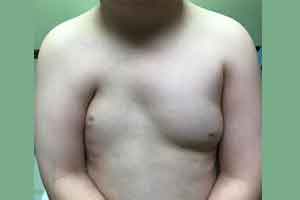- Home
- Editorial
- News
- Practice Guidelines
- Anesthesiology Guidelines
- Cancer Guidelines
- Cardiac Sciences Guidelines
- Critical Care Guidelines
- Dentistry Guidelines
- Dermatology Guidelines
- Diabetes and Endo Guidelines
- Diagnostics Guidelines
- ENT Guidelines
- Featured Practice Guidelines
- Gastroenterology Guidelines
- Geriatrics Guidelines
- Medicine Guidelines
- Nephrology Guidelines
- Neurosciences Guidelines
- Obs and Gynae Guidelines
- Ophthalmology Guidelines
- Orthopaedics Guidelines
- Paediatrics Guidelines
- Psychiatry Guidelines
- Pulmonology Guidelines
- Radiology Guidelines
- Surgery Guidelines
- Urology Guidelines
Poland syndrome: a case report

Poland syndrome (PS) is a rare chest wall developmental anomaly characterised by ipsilateral agenesis/hypoplasia of the sternocostal head of pectoralis major, hypoplasia of nipple or breast, absence of subcutaneous fat, multiple rib abnormalities, elevated and rotated scapula (Sprengel deformity) and ipsilateral digit abnormalities (brachydactyly, syndactyly). These findings vary and all are rarely found in a single individual.
The present case involves an 8-year-old boy with no medical history who presented for evaluation of chronic rhinitis. There was no breathing or cardiac complaints on review of systems. Physical examination showed chest asymmetry with right anterior chest wall depression and flattening of the right pectoral region with displaced nipple (figure 1). Abduction of the shoulders showed absence of the sternocostal head of pectoralis major. Hand examination did not show any signs of ipsilateral digital abnormality.
PS was first described by Alfred Poland in 1840. Aetiology of PS remains unknown. It is rarely genetically inherited and is regarded as a sporadic event. It has been suggested that during the sixth week of gestation, the injury occurs due to regional vascular defect of the subclavian artery.1It is a period associated with splitting of the two heads of pectoralis major and the development of tissues between the digits.
Treatment is primarily reconstructive surgery depending on the severity of the malformation, gender and patient preference. Generally, the reconstructive path is complex and must be performed stepwise because the malformation involves alteration of different tissues (skin, subcutaneous tissue, muscle, breast). Cardiac or respiratory complaints should alert the healthcare provider for further work-up. Left-sided PS has been associated with dextrocardia particularly in patients with agenesis of two or more ribs. The ‘vascular theory’ has been proposed for other variants of this syndrome such as Mobius and Klippel-Fiel. Several cases have described an association with neoplasms such as neuroblastoma, leukaemia, leiomyosarcoma, breast cancer and Wilms tumour.
Reconstructive surgery is planned for this patient after growth completion. The patient has remained asymptomatic and will follow up with cardiothoracic surgery after growth completion.

Disclaimer: This site is primarily intended for healthcare professionals. Any content/information on this website does not replace the advice of medical and/or health professionals and should not be construed as medical/diagnostic advice/endorsement or prescription. Use of this site is subject to our terms of use, privacy policy, advertisement policy. © 2020 Minerva Medical Treatment Pvt Ltd